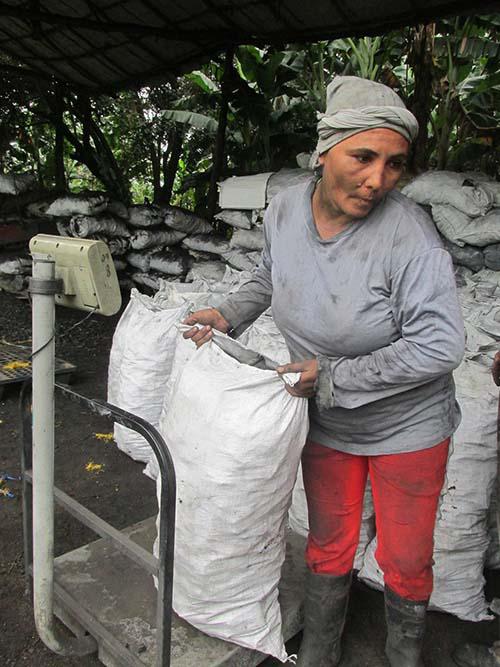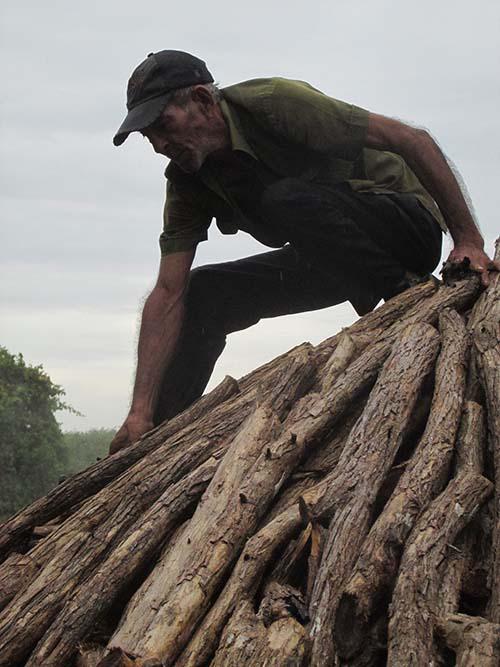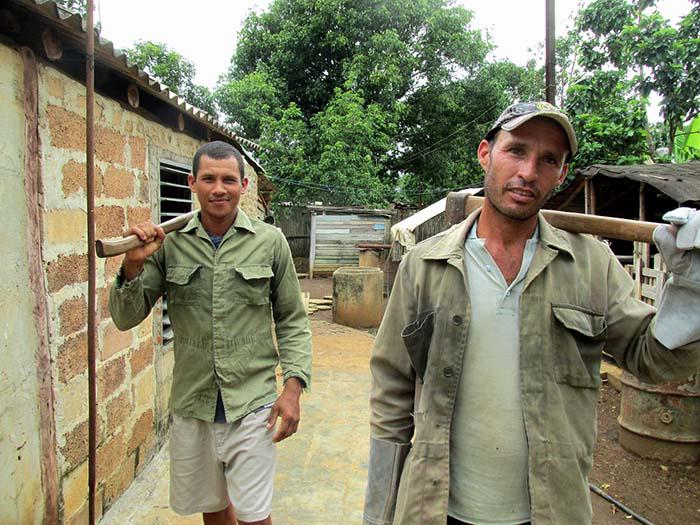
Morón, Ciego de Ávila.-They walk along a wide horizon, covering kilometers and kilometers. The scenery is not pleasant: weeds, roads, ditches, water, mud, rough terrain... until they reach the marabú (marabou-thorn or sickle bush) and these men and women do the impossible.
In the countryside, everything has its own pace and skill, but the protagonists of this story are specialists in making charcoal from marabou-thorn, which is abundant in the fields of Cuba. Believe it or not, this is a task which is popular among many who work for the Ceballos Agro-industrial Enterprise, which has units in several Cuban provinces: Las Tunas, Camagüey, Ciego de Ávila and Sancti Spíritus. They are fiercely opposed to the extermination of this thorny plant, widely considered an invasive weed.
The popularity of this line of work stems from the fact that a single worker can earn over 8,000 CUP a month. Meanwhile, the enterprise has received almost 65 million pesos from exports of marabou charcoal since 2005, making it the nationwide leader in this sector.
BETWEEN THE PAST AND THE PRESENT
Charcoal makers are always caught up in the routine of going out, or living in, the wetlands; chopping wood, bringing it to the area where the kilns are built, covering them with grass, dirt, or corn stover, as they do in the community of San Antonio – burning and watching over the charcoal for days.
Those of today, I thought as I watched several of them, although not walking around in fancy clothing, are of a new era: a cell phone in their pocket, rubber boots, axe, or in some cases a chainsaw in hand, with homes which are by no means poor and a salary of several thousand pesos, depending on the amount of charcoal they produce.
Those of the past were like rolling stones. Way back in 1955, when the homeland’s brightest January ever was yet to arrive, Onelio Jorge Cardoso in the magazine Carteles drew these workers with a brushstroke of words: “Life itself for the charcoal burner, submerged in the wetlands and poverty, can not be measured if the time it takes a man to make his kiln, finish, and collect payment is not shared in all its rigor (...) all their shacks have roofs of palmetto leaves.”

“One earns just enough to live, to pay for food,” 76-year-old Antonio Marcos, the greatest storyteller in the area, told Cardoso, sitting on a rough four-legged stool. “One has to pay for the footwork across the fields, the dragging, unloading, and the truck, such that one losses 60 pesos from 100 sacks.”
He continued: “We have left a kiln of over 500 sacks burning, with an open mouth to the side, and from the estuary, submerged up to our necks, we watched how we lost what had taken 30 days to cut, bring, and pile up. There, with out feet buried in the mud, with water up to our jaws, and corasí (type of mosquito) above so big you could cut them with a knife, we watched how what had cost us our heart and soul burned.”
LIVING OFF MARABOU
Pablo Parra Gómez looks older than he actually is. He says that the rough country is to blame. He claims to have a doctorate in marabou and charcoal, a perfect pairing for his pocket. “I have never earned as much money as I do now,” he states, although he notes that his lungs are not in such a good condition, “due to the smoke from the kiln and the obligatory smoking in all those sleepless nights.” Despite this, he still loves the land and is capable of staying awake for three days and nights with his eyes fixed on a kiln of 180 sacks. “I've never lost one,” he says.
“That one you see over there, I have been watching over for nine days, to make sure it doesn’t explode or a hole opens up, through which all that effort can evaporate into thin air,” Pablo tells this journalist and José López Triana, head of the brigade.
He explains that there are many charcoal burners in the area and they must travel increasing further out in oxcarts to find marabou, and bring it to the level ground where they build the kiln with the patience of a goldsmith. They begin by driving a guide into the ground and surrounding this by “little sticks”, until it is covered with wood, then grass, corn stover, or “anything that can plug it up”, which is then covered with earth before being set alight either by throwing some burning charcoal or a piece of sack doused in petrol into the top of the cone-shaped kiln, so that the marabou begins to burn. That’s when the watch starts.
Nerkis Porra Batista, 28, has spent 13 years in this line of work, and notes, “Here we have built some really big kilns, up to 1,200 sacks. Once we made one that we called the dead horse - completely horizontal - that was a real commotion, but we had to throw a tremendous amount of sticks on it, because we measure the size by the carts that we bring.”
The charcoal burners of today do not speak in terms of cords of firewood (a form of measurement), as those of the past did, this term has been lost, but the older ones, like Pablo, know that each cord has a volume of just over 3.5 cubic meters. “Each cart can hold 3 or 4 cords,” he explains.
As we move through a guardarraya (path between reed beds) lined with marabou-thorn, the old MTZ tractor towing us through the wetlands roars. The cart follows it reluctantly, like a bucking animal, with the wheels jammed and almost without turning, but it advances. We’re heading for San Andrés, where “El Conejo” (The Rabbit), as Raúl Martínez Cáceres is known, is likely felling the bush.
On arriving, we spot three kilns, all belonging to Raúl and Yuniel Llorente Guerra, his partner on the job. You don’t have to get very close to hear and see them at work. The axe soars over the heads of both and slams into the logs. They have sharpened it several times since arriving at 5.00 am.

“The axes today are not very good, but this beauty sings as it cuts through the air,” The Rabbit explains, a nickname resulting from his agility working on the land. “I am here today and gone tomorrow. The marabou comes and goes. There are areas that we felled six or seven years ago and they are already infested again. That suits us.
“Before I worked with other enterprises, even from Camagüey, but since I began working for the citrus (Ceballos) enterprise, I haven’t wanted to work for anyone else. In one month and five days I can earn over 8,000 pesos. Imagine!”
Raúl has many memories to share, as his father and grandfather were also charcoal burners and told him their stories: “Before, it was a miracle the charcoal burner survived. He went out into the fields without shoes, with ragged clothes, and all for a few cents.”
Thus The Rabbit concludes his short story. He is happy but not satisfied, as the family tradition will end with him. “I do not want my son to be a charcoal burner. It is a very difficult job. The land is unforgiving, and marabou even less so.”
FROM THE WETLANDS TO EUROPE
The woody plant can form dense thickets, almost impenetrable for animals and humans. It is estimated that there are more than 1.5 million hectares “infested” with the “weed” in Cuba. According to the tons of charcoal produced (more than 198,000 in 11 years), the Ceballos Agro-industrial Enterprise has managed to clear just 9,000 hectares of the plant, although, of course, this does not represent a contiguous area, as the marabou is cut where plantations have the best conditions.
Alejandro Hernández Díaz, director of the Charcoal Collection and Processing Basic Enterprise Unit, notes that more than 600 people work in this sector across five provinces: Granma, Las Tunas, Camagüey, Ciego de Ávila and Sancti Spíritus.
According to Jorge Sánchez González, export director of the enterprise, Cuban charcoal is popular among clients in Italy, Greece, Turkey and Portugal.
Erdal Demiralay, a Turkish businessman, confirmed as such speaking to Granma International, noting that of all types of charcoal he prefers that made from marabou, and, specifically, that sold by the Ceballos Agro-industrial Enterprise.
“Currently we receive eight containers every month from Ceballos, and in the near future we hope to raise this figure to twenty, as the product is of great quality and the enterprise is very responsible in fulfilling contracts.
“Now we want the so-called canelino charcoal (which is made from the branches of marabou plants). We use it mainly in food processing and hookahs (used for smoking), a very old tradition in my country.”
We return almost at dusk. The same weeds, roads, guardarrayas, water, mud, twists and turns... until the marabou becomes a green spot on the horizon... and charcoal.















